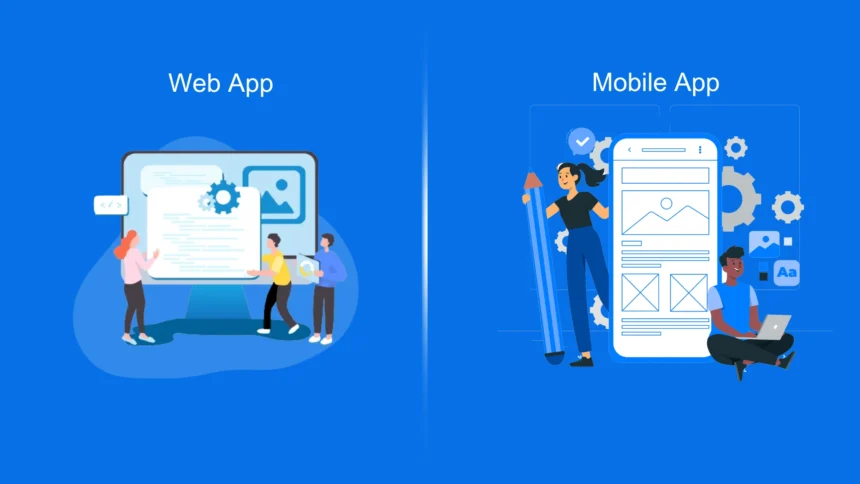Introduction
In today’s hyperconnected digital landscape, having a robust online presence is no longer optional it’s essential for businesses of every size and industry. Organizations that fail to invest in professional web and mobile app development services risk being overshadowed by competitors who leverage modern technology to reach and engage their audiences more effectively. From streamlined user experiences and enhanced security to scalable architectures and data-driven insights, the multifaceted benefits of professional development translate into tangible returns on investment (ROI).
This comprehensive blog post delves into the key advantages of partnering with specialized web and mobile app development teams, illustrating how such collaborations can bolster brand credibility, accelerate time-to-market, and future-proof your digital assets in an ever-evolving technological ecosystem.
Understanding the Importance of Professional Development Services
Expertise and Technical Proficiency
Professional web and mobile app development agencies bring together cross-functional teams comprising front-end and back-end developers, UX/UI designers, quality assurance engineers, project managers, and DevOps specialists. Each member contributes deep domain knowledge, technical skills, and industry best practices to ensure that your applications not only meet functional requirements but also adhere to performance, security, and accessibility standards.
By contrast, DIY platforms and generic templates often lack the customization, optimization, and maintainability required for complex business needs. Professional teams conduct thorough requirements analysis, system architecture design, and technology stack evaluation, selecting frameworks and tools that align with your project goals and long-term vision.
Customized Solutions Tailored to Your Business
Every organization operates within a unique context, with specific workflows, target audiences, and branding guidelines. Professional development services prioritize bespoke solutions that cater to these distinct elements. From custom UI components and interactive prototypes to advanced back-end integrations and real-time data processing, tailored applications enhance operational efficiency and deliver unparalleled user experiences.
Whether you need an enterprise resource planning (ERP) system, e-commerce platform, customer relationship management (CRM) integration, or mobile app with location-based services, experienced developers architect solutions that precisely align with your business model, growth trajectory, and user expectations.
Future-Proof Architecture and Scalability
Growth is inevitable for successful digital products, but unplanned growth can strain infrastructure, degrade performance, and compromise user satisfaction. Professional developers anticipate scaling requirements by adopting microservices patterns, containerization, and cloud-native approaches on platforms like Amazon Web Services (AWS), Microsoft Azure, or Google Cloud Platform (GCP).
Auto-scaling, load balancing, and distributed database configurations ensure that your applications remain responsive and available, even under high traffic loads. Moreover, modular and loosely coupled designs facilitate the addition of new features, third-party integrations, and updates, minimizing downtime and technical debt.
Enhancing User Experience (UX) and Engagement
Intuitive Design and Accessibility
A user-centric approach is fundamental to retaining visitors and converting them into loyal customers. Professional developers collaborate with UX/UI designers to create intuitive navigation, clear visual hierarchies, and accessible interfaces that accommodate users with diverse needs.
Accessibility compliance aligning with Web Content Accessibility Guidelines (WCAG) 2.1 ensures that individuals with visual, auditory, or motor impairments can interact seamlessly with your digital products. Responsive design and mobile-first principles guarantee consistent experiences across smartphones, tablets, and desktops, enabling your audience to engage with your brand wherever and whenever they choose.
Optimized Performance for Reduced Bounce Rates
Performance is a critical determinant of user satisfaction and search engine ranking. Slow-loading pages frustrate users and lead to high bounce rates, costing businesses potential revenue and damaging SEO efforts.
Professional development teams implement performance optimization techniques, such as code splitting, lazy loading, image compression, and strategic caching, to minimize page load times. Core Web Vitals metrics introduced by Google to measure real-world user experience guide developers in fine-tuning applications for fast first paint, quick interactivity, and stable layouts, ultimately improving engagement and conversion rates.
Continuous Improvement Through Analytics and Testing
Professional agencies integrate analytics solutions Google Analytics, Mixpanel, or Amplitude to monitor user behavior, track key performance indicators (KPIs), and identify areas for enhancement. A/B testing, heat mapping, and session recording tools enable data-driven refinements to UI elements, content placement, and feature workflows.
By embracing an iterative development process, teams can rapidly deploy updates, validate hypotheses, and optimize user journeys based on empirical evidence, ensuring that your digital products evolve in alignment with audience preferences and market trends.
Strengthening Security and Compliance
Proactive Vulnerability Management
Cyber threats are continuously evolving, with new attack vectors emerging daily. Professional developers conduct comprehensive security audits, vulnerability assessments, and penetration testing to identify and remediate weaknesses in your applications.
Implementing industry-standard security protocols such as Secure Sockets Layer (SSL)/Transport Layer Security (TLS) encryption, OAuth 2.0, JSON Web Tokens (JWT), and multifactor authentication safeguards sensitive user data and fortifies your defenses against common attack vectors like SQL injection, cross-site scripting (XSS), and cross-site request forgery (CSRF).
Regulatory Compliance and Data Privacy
Organizations operating in regulated industries finance, healthcare, e-commerce must adhere to stringent data privacy and security regulations, including the General Data Protection Regulation (GDPR), California Consumer Privacy Act (CCPA), Health Insurance Portability and Accountability Act (HIPAA), and Payment Card Industry Data Security Standard (PCI DSS).
Professional teams ensure that your applications implement data handling, storage, and transmission protocols that comply with relevant regulations, reducing legal liabilities and building trust with customers. Detailed audit trails, data encryption at rest, and secure key management practices are integral components of compliant development workflows.
Maximizing SEO and Digital Marketing Impact
On-Page SEO Best Practices
Visibility in search engines is a vital driver of organic traffic and long-term ROI for digital products. Professional web developers implement on-page SEO strategies, including semantic HTML markup, appropriate use of heading tags (H1, H2, H3), metadata optimization, canonical URLs, and structured data (schema.org) to enhance search engine understanding and indexing.
Creating dynamic XML sitemaps, optimizing robots.txt, and integrating content delivery networks (CDNs) further improve crawlability and load performance, positioning your site for higher rankings and better user experiences.
Technical SEO and Mobile Optimization
Mobile-first indexing by Google underscores the necessity of optimized mobile experiences. Developers ensure that mobile page structures, content hierarchies, and resource loading patterns are conducive to efficient crawling by search engine bots. Minimizing render-blocking resources, optimizing critical CSS and JavaScript, and leveraging progressive web app (PWA) technologies such as service workers for offline support elevate both user convenience and SEO performance, while reducing dependency on app store distribution channels.
Integrations and Ecosystem Cohesion
API-Driven Architectures
Modern businesses leverage multiple software solutions customer relationship management (CRM), enterprise resource planning (ERP), marketing automation, payment processing gateways, and more. Professional development services specialize in API-driven architectures, creating RESTful or GraphQL endpoints that facilitate seamless data exchange between disparate systems.
This interoperability streamlines workflows, reduces manual data entry, and empowers real-time analytics, enabling stakeholders to make informed decisions with current and accurate information.
Third-Party Integrations and Custom Connectors
Whether integrating with Salesforce, HubSpot, Stripe, PayPal, or custom in-house applications, professional developers build robust connectors and middleware to ensure reliable data synchronization and error handling. Event-driven architectures using webhooks or message queues (e.g., RabbitMQ, Apache Kafka) support asynchronous data processing and decoupled system interactions, enhancing fault tolerance and scalability for mission-critical operations.
Long-Term Cost Efficiency and Maintenance
Reducing Technical Debt
Shortcuts in code quality, documentation, and architectural planning can lead to technical debt a buildup of inefficiencies that hinder future development and inflate maintenance costs. Professional teams emphasize clean code principles, modular components, and comprehensive documentation to ensure that your codebase remains understandable, extensible, and reusable.
Regular refactoring and code audits prevent degradation of code quality over time, while automated testing frameworks unit, integration, and end-to-end tests catch regressions early, reducing debugging efforts and minimizing production incidents.
Managed Services and Support Agreements
Many development agencies offer ongoing managed services, encompassing performance monitoring, security patching, and feature updates under service level agreements (SLAs). These agreements define response times, uptime guarantees, and maintenance schedules, providing peace of mind and predictable costs for sustaining and evolving your digital products.
Proactive monitoring using tools like New Relic, Datadog, or Prometheus alerts teams to performance anomalies, enabling swift remediation before issues impact end users.
Accelerating Time-to-Market
Agile and DevOps Practices
Agile methodologies Scrum and Kanban empower teams to deliver incremental value through iterative sprints, frequent releases, and continuous stakeholder feedback. Combined with DevOps practices—continuous integration (CI), continuous delivery (CD), and infrastructure as code (IaC) projects achieve high release velocity, consistent environments, and automated deployment pipelines.
By reducing manual handoffs and automating repetitive tasks, professional teams can rapidly validate features, incorporate user feedback, and minimize time spent on non-value-added activities.
Leveraging Open-Source Frameworks and Tooling
Experienced developers leverage the vast ecosystem of open-source frameworks, libraries, and community-driven tools to accelerate development cycles. Whether building Single Page Applications (SPAs) with React or Vue.js, cross-platform mobile apps with React Native or Flutter, or backend services with Node.js, Django, or .NET Core, reusable components and community-maintained modules reduce boilerplate code and expedite complex feature implementations. This approach allows your team to focus on unique business logic and core differentiators rather than reinventing foundational functionality.
Competitive Advantage and Brand Credibility
Professional Quality as a Differentiator
Your digital presence often forms the first impression for potential customers, partners, and investors. Flawless user experiences, polished interfaces, and reliable performance project professionalism and build trust. In crowded markets, brands that invest in high-quality web and mobile applications stand out, convey expertise, and justify premium pricing. Enhanced credibility attracts high-value clients, retains customers longer, and strengthens brand loyalty, contributing to sustained revenue growth.
Innovation Through Emerging Technologies
Staying ahead of the curve requires adopting emerging technologies like artificial intelligence (AI), machine learning (ML), augmented reality (AR), virtual reality (VR), blockchain, and the Internet of Things (IoT). Professional development firms continuously explore pilot projects, proof-of-concept applications, and research initiatives that integrate these technologies into client solutions.
Whether implementing AI-driven chatbots for customer service, AR-powered product visualization, or blockchain-based supply chain tracking, such innovations differentiate your offerings and position your business as an industry leader.
Measuring Success: Analytics, KPIs, and ROI
Defining and Tracking Key Performance Indicators
Setting clear objectives and measurable KPIs is crucial to evaluating the success of your digital investments. Common metrics include user acquisition cost (UAC), customer lifetime value (CLV), conversion rates, churn rates, average session duration, and task completion rates. Professional agencies collaborate with stakeholders to align goals, configure analytics platforms, and generate executive dashboards that provide real-time visibility into performance trends and areas for optimization.
Interpreting Data-Driven Insights
Raw data without context offers limited value. Professional teams employ data science techniques cohort analysis, funnel analysis, and predictive modeling to uncover actionable insights. Identifying patterns in user behavior, segmenting audiences based on engagement levels, and forecasting growth trajectories enable targeted marketing campaigns, personalized user experiences, and strategic product enhancements that drive ROI and maximize customer satisfaction.
Conclusion
Investing in professional web and mobile app development services transcends mere cost expenditure; it represents a strategic imperative for organizations seeking to thrive in an increasingly competitive and technology-driven marketplace. From technical expertise and customized solutions to superior user experiences, robust security, and data-driven optimization, the benefits of professional partnerships are manifold and far-reaching.
By embracing agile practices, leveraging emerging technologies, and prioritizing long-term maintainability, businesses can accelerate time-to-market, strengthen brand credibility, and adapt seamlessly to changing market demands.
As you embark on your digital transformation journey, consider evaluating potential development partners based on their proven track record, domain expertise, client testimonials, and alignment with your organizational vision. A well-chosen partnership can unlock unparalleled value, foster innovation, and pave the way for sustained growth and success in the digital age.




